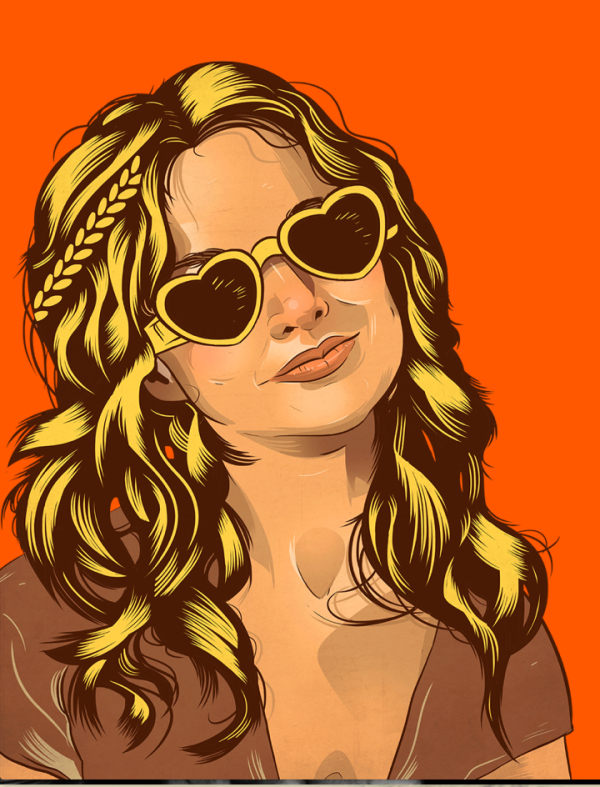Illustration by ALEX WELLS
GRANTLAND: Boogie Nights began as a teenage boy’s wet dream. Nearly a decade before its 1997 release, it was a fantasy to chase. The year was 1988. The boy was a precocious, plotting 17-year-old named Paul Thomas Anderson. He was growing up in Los Angeles’s San Fernando Valley, obsessed with the studios all around him. He wanted in and hustled plenty — sneaking onto sets, working a Betamax camera from the age of 12, filming everything — but he also gained entrée from his father, Ernie, who was famous from his voice-over work for ABC on shows like The Love Boat. The Andersons had a pool — where funny-guy actors like Tim Conway and Robert Ridgely frequently lounged, cracking jokes and pouring drinks — and their own Shetland pony. The absurd and the domestic were one and the same.
Anderson also became consumed by porn and the Bizarro Hollywood industry that claimed the Valley as its Fertile Crescent. His relationship to the material differed from that of the average high schooler. There was the fucking, sure. But the real seduction was in the imagined backstories, the circumstantial tragicomedies of the casts and crews, which inspired Anderson to write and film The Dirk Diggler Story, a 32-minute mockumentary-style short about the pursuit, delusions, and costs of fame.
When he was 26, Anderson’s first full-length feature, Sydney, had run into problems. The production company Rysher Entertainment made its own cuts to his Reno-set gambling story and released it under a different title, Hard Eight. During the process, Anderson squabbled with producers, barred them from the set, and refused to show any edited footage or make any significant suggested changes. But he didn’t have final cut and was eventually fired and locked out of his own editing room.
In the fallout, Anderson told a reporter that his experience on Sydney “created a sort of paranoia and guardedness in me that I’m glad I have because that will never, ever happen to me again.” When he set out to film Boogie Nights, it was with a resolve bordering on arrogance. Compromise wasn’t part of the plan. Still, after an intense production and postproduction period — one in which the director had to manage a cranky, confused Burt Reynolds and an untested, rapping underwear model named Mark Wahlberg — Anderson was forced once again to fight studio heads for his cut of the film.
But Anderson’s vision prevailed this time. Nearly 20 years later, Boogie Nights endures. For its beautiful portrait of nontraditional families; for Reynolds and Wahlberg, the surrogate father and son, who were never better; for Philip Seymour Hoffman, squeezing into character and breaking hearts; for its prodigy director sticking to his guns and nailing it; for John C. Reilly’s hot-tub poetry; for Roller Girl. Is everybody ready? This is the making and near unmaking of Boogie Nights. MORE
WIKIPEDIA: The film was Anderson’s first real production having experimented with what he called “standard fare”.[1][2] Anderson conceived the film when he was 17 years old[3][4] and a senior at Montclair College Preparatory School.[1] Anderson called his friend Michael Stein, telling him to come over for a production meeting, and told Stein his idea: “John Holmes”.[5] Stein loved the idea and was cast to play the role of Dirk Diggler; he selected his own wardrobe.[5] Stein showed Anderson some video of his friend Eddie Dalcour, who was a professional body builder, which Anderson loved and cast him in the role of Reed Rothchild.[5] Anderson’s father, Ernie Anderson, narrated the film and Robert Ridgely, a friend of Anderson’s father, played the role of Jack Horner.[5]
The film was shot in 1987[3] using a video camera and steadicam provided by Anderson’s father.[5] Some scenes were shot at a motel.[1] Anderson raised money for the film by cleaning cages in a pet store.[1] Being influenced by This is Spinal Tap at the time, he decided to do a mockumentary[6] and used the John Holmes documentary, Exhausted, as a model for the film, even taking some dialogue almost word-for-word.[5] Anderson worked from a shot list and wanted the actors to be serious since the characters took their work seriously.[5] Anderson edited the film using two VCRs.[7] According to Anderson, the film drew admiring laughs when it was shown at a University of Southern California film festival.[2]
The Dirk Diggler Story was expanded into Anderson’s 1997 breakout film Boogie Nights[3][8][9][10] with a number of scenes appearing almost verbatim in both films.[5] Two actors had roles in both films; in Boogie Nights, Robert Ridgely played The Colonel, a pornography financier, and Michael Stein had a cameo appearance as a stereo store customer.[9] The main differences between The Dirk Diggler Story and Boogie Nights are the mockumentary versus narratives styles in the former and latter films, respectively;[6] Diggler’s stint in gay porn in the first film versus his prostitution in the second;[5] and Diggler’s dying from an overdose in the first film versus his happy return to his former roles and lifestyle in the second.[7] MORE

